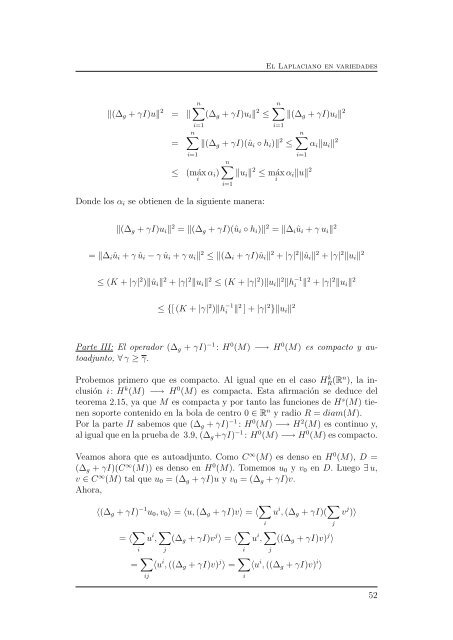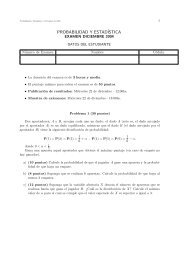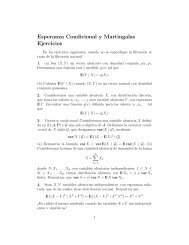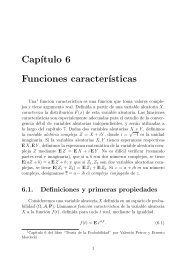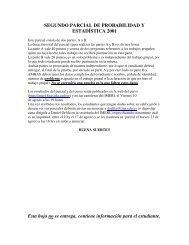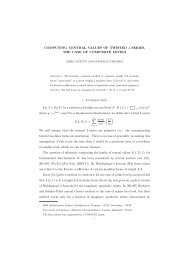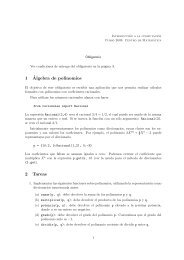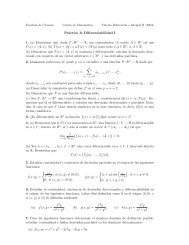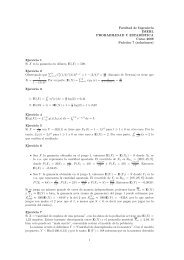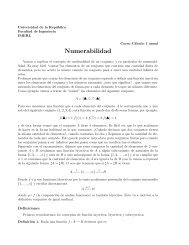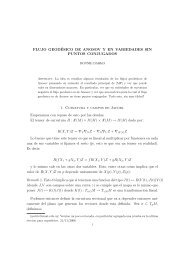El Laplaciano en Variedades Riemannianas - Centro de Matemática
El Laplaciano en Variedades Riemannianas - Centro de Matemática
El Laplaciano en Variedades Riemannianas - Centro de Matemática
You also want an ePaper? Increase the reach of your titles
YUMPU automatically turns print PDFs into web optimized ePapers that Google loves.
<strong>El</strong> <strong>Laplaciano</strong> <strong>en</strong> varieda<strong>de</strong>s‖(∆ g + γI)u‖ 2 = ‖=≤n∑(∆ g + γI)u i ‖ 2 ≤i=1n∑‖(∆ g + γI)u i ‖ 2i=1n∑‖(∆ g + γI)(û i ◦ h i )‖ 2 ≤i=1(máxiα i )n∑i=1Don<strong>de</strong> los α i se obti<strong>en</strong><strong>en</strong> <strong>de</strong> la sigui<strong>en</strong>te manera:n∑α i ‖u i ‖ 2i=1‖u i ‖ 2 ≤ máxiα i ‖u‖ 2‖(∆ g + γI)u i ‖ 2 = ‖(∆ g + γI)(û i ◦ h i )‖ 2 = ‖∆ i û i + γ u i ‖ 2= ‖∆ i û i + γ û i − γ û i + γ u i ‖ 2 ≤ ‖(∆ i + γI)û i ‖ 2 + |γ| 2 ‖û i ‖ 2 + |γ| 2 ‖u i ‖ 2≤ (K + |γ| 2 )‖û i ‖ 2 + |γ| 2 ‖u i ‖ 2 ≤ (K + |γ| 2 )‖u i ‖ 2 ‖h −1i ‖ 2 + |γ| 2 ‖u i ‖ 2≤ {[ (K + |γ| 2 )‖h −1i ‖ 2 ] + |γ| 2 }‖u i ‖ 2Parte III: <strong>El</strong> operador (∆ g + γI) −1 : H 0 (M) −→ H 0 (M) es compacto y autoadjunto,∀ γ ≥ γ.Probemos primero que es compacto. Al igual que <strong>en</strong> el caso H k R (Rn ), la inclusióni: H k (M) −→ H 0 (M) es compacta. Esta afirmación se <strong>de</strong>duce <strong>de</strong>lteorema 2.15, ya que M es compacta y por tanto las funciones <strong>de</strong> H s (M) ti<strong>en</strong><strong>en</strong>soporte cont<strong>en</strong>ido <strong>en</strong> la bola <strong>de</strong> c<strong>en</strong>tro 0 ∈ R n y radio R = diam(M).Por la parte II sabemos que (∆ g + γI) −1 : H 0 (M) −→ H 2 (M) es continuo y,al igual que <strong>en</strong> la prueba <strong>de</strong> 3.9, (∆ g +γI) −1 : H 0 (M) −→ H 0 (M) es compacto.Veamos ahora que es autoadjunto. Como C ∞ (M) es d<strong>en</strong>so <strong>en</strong> H 0 (M), D =(∆ g + γI)(C ∞ (M)) es d<strong>en</strong>so <strong>en</strong> H 0 (M). Tomemos u 0 y v 0 <strong>en</strong> D. Luego ∃ u,v ∈ C ∞ (M) tal que u 0 = (∆ g + γI)u y v 0 = (∆ g + γI)v.Ahora,〈(∆ g + γI) −1 u 0 , v 0 〉 = 〈u, (∆ g + γI)v〉 = 〈 ∑ iu i , (∆ g + γI)( ∑ jv j )〉= 〈 ∑ iu i , ∑ j(∆ g + γI)v j 〉 = 〈 ∑ iu i , ∑ j((∆ g + γI)v) j 〉= ∑ ij〈u i , ((∆ g + γI)v) j 〉 = ∑ i〈u i , ((∆ g + γI)v) i 〉52


